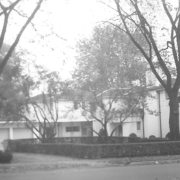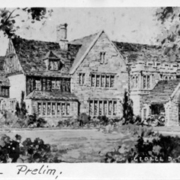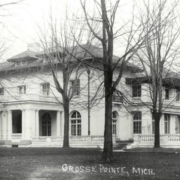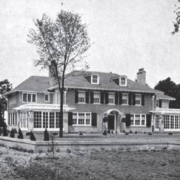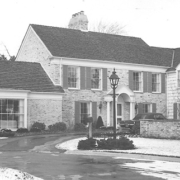Historical Architecture of Grosse Pointe – 10 Provencal
Last week we presented the lost estate 10 Moross – on the corner of Moross and Lake Shore. It is believed this once grand home was designed in the early 20th century (around 1905) by Louis Kamper and razed in 1968.
This week we head to another prominent street off of Lake Shore to explore 10 Provencal, located at the foot of the hill of this prestigious road in Grosse Pointe Farms. The International style home was completed in 1937. Giffels & Vallet Inc., L. Rosetti designed the property for Le Roy Ernest Swift and his wife Marjorie I. McMillan. John Weinhandt built it.
10 Provencal is constructed from concrete and steel with a smooth, untextured flat surface. Large windows and sweeping balconies dominate the front elevation, as does the enormous circular bay window that provides a perfect view of the lake. The shape of the property, the porthole windows, and balcony railings give this home a ship-like appearance – not unusual for International and Art Deco style homes created during the 1930’s.

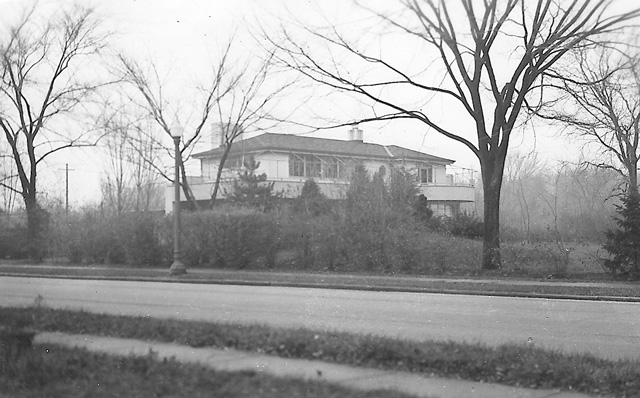
The home is currently 5,800 sq ft, but over the years it is believed the property has been significantly enlarged (partly by adding an extension above the 3-car garage), while extensive renovations have also been made. From a listing, in 1979, we can confirm the main floor featured a 25 x 18 sq ft living room (with natural fireplace), and the 15’ x 19’ sq ft dining room is the location of the stunning circular bay window. The floors on the main floor were concrete with cork. Also on the main floor were a 19’ x 14’ sq ft garden room, and a 10’ x 11’ sq ft library, along with two bedrooms for maids, and service stairs. A terrace wrapped around a large portion of the first floor, from the living room to the far side of the dining room – as depicted in the floor plans below. The second floor included three bedrooms, a dressing room and a two-bedroom apartment. A balcony also wraps around a large part of the second floor that faces the lake. *Please note the floor plan has changed significantly from 1979, to its current layout.
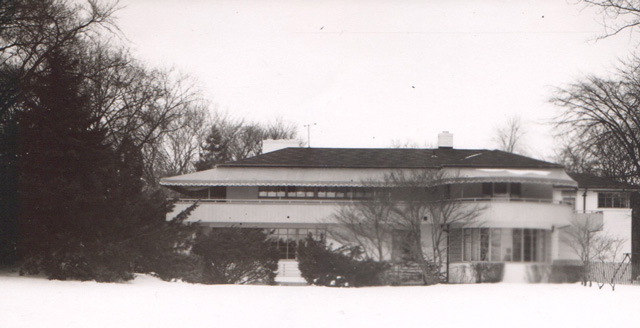
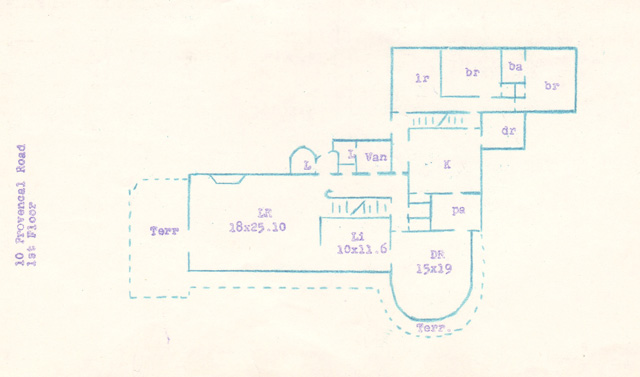
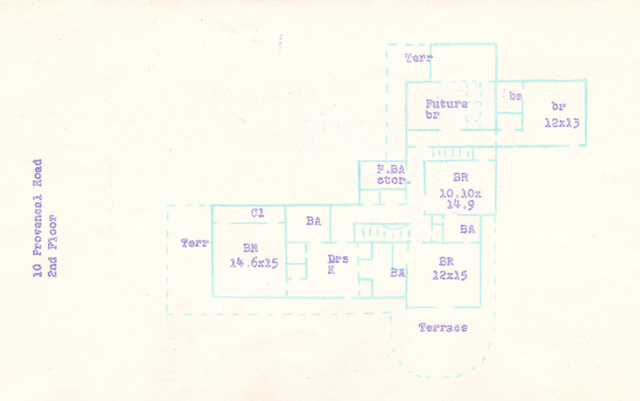
It appears the Swift family resided at 10 Moross until around 1955. Mr. Swift listed the property for sale, in 1955, for $85,000 (around $835,000 today). From our files it appears Mr. Swift was willing to sell part of the lot – the frontage on Lake Shore (measuring 146’ x 150’) for $25,000. The house, set back 200 feet, was then priced separately at $60,000 (around $588,000 today). It appears Dr. P. J. Dwaihy purchased the entire property that same year for $72,500 (around $711,000 today).
From our files we understand Dr. Dwaihy also wanted to significantly alter the lot. The lot size at the time, in 1957, measured 146’ (on Lake Shore); 145’ (west line); 375’ (Provencal Rd); and 354’ (north line). In 1957, Dr. Dwaihy listed the home for $92,500 (around $907,000 today). He too was willing to sell the front part of the lot (for $30,000), rather than selling the house, if the buyer would promise to build a ‘smaller type house’.
In 1960, the purchase was completed for the 185’ x 146’ front part of the lot (this is now the location of 4 Provencal – completed in 1964). Meanwhile 10 Moross was listed separately on the remaining 190’ x 145’ part of the property – this is the size of the lot today. Three years later, in 1963, Dr. W. H. Knapp purchased 10 Moross. It appears Dr. Knapp only resided in the home for four years before it was sold to N. John McNeil. The property was sold again in 1978, to Edwin Norman.
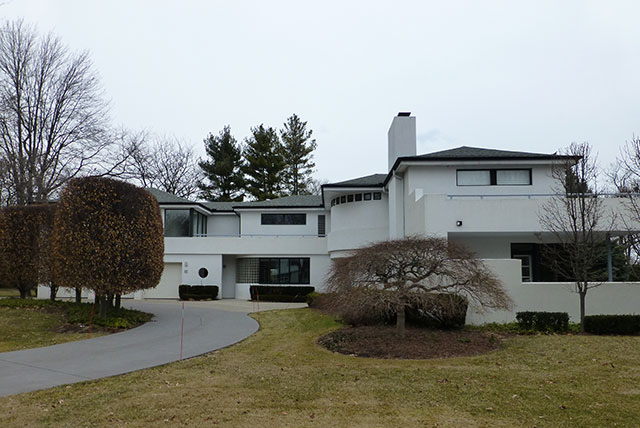
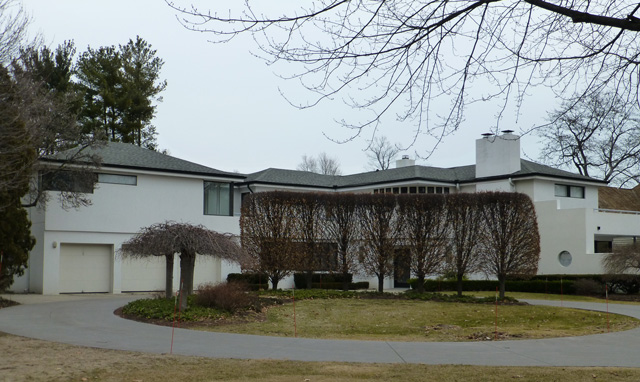
International Style is an important architectural movement that began to gain popularity during the 1920’s and 1930’s. It is closely related to modernism and modern architecture. The term “International Style” first came into play via a 1932 exhibition organized by American architects Henry-Russell Hitchcock and Philip Johnson – ‘Modern Architecture: International Exhibition’, which declared and labeled the architecture of the early 20th century as the “International Style”. Source: Wikipedia.
The International Style began to gather pace in the US at the beginning of the 1930’s. Many US cities on the east coast started the construction of skyscrapers – lead by pioneering architects in this moment such as Philip Johnson – whilst groundbreaking residential projects were also being created by Frank Lloyd Wright and Eliel Saarinen, to name but a few.
Based on research from Wikipedia the most common exterior characteristics of International Style buildings are rectangular shape; utilitarian materials such as concrete, steel and glass; smooth, untextured flat surfaces, typically alternating with areas of glass; rounded corners; and taut plane surfaces that have been completely stripped of applied ornamentation and decoration.
The architect of 10 Provencal, Louis Rossetti, was born in Paris in 1895. He served in World War 1 as a captain, receiving the silver medal of valor for his service. In 1924, after graduating from Rome University, he won a scholarship to travel to America and quickly established himself as an architect in Detroit. In 1929, he joined the firm of Raymond Giffels & Victor Vallet as a partner – the firm was renamed as Giffels & Vallet Inc., L. Rosetti, Associated Engineers & Architects.
By the 1950’s, the now renamed firm – Giffels & Rosetti, had become one of the largest firms in the country, had over 950 employees, and produced work around the world. The firm was responsible for the design of the original Cobo Hall in Detroit, the Jeffersonian Apartments, and the main Terminal Building at the Wayne County Metro Airport (1958). In 1963, Raymond Giffels and Louis Rossetti went their separate ways. Both established their own firms that still exist today in Detroit and Southfield respectively.
Aside from 10 Provencal there are several excellent examples of International style homes in and around Grosse Pointe – we wish there were more.
*Photos courtesy of the Higbie Maxon Agney archives unless stated.
Written by Katie Doelle
Copyright © 2021 Katie Doelle

